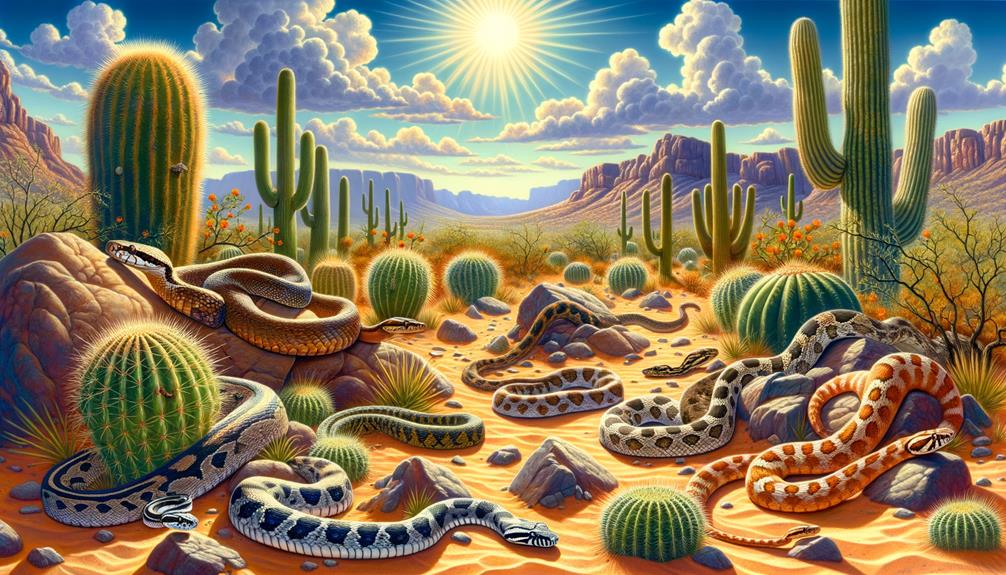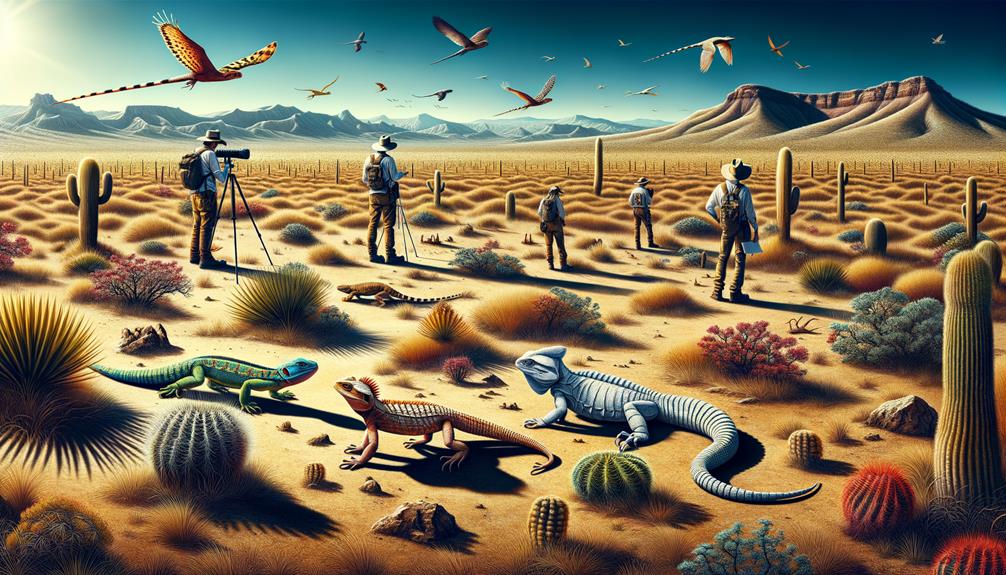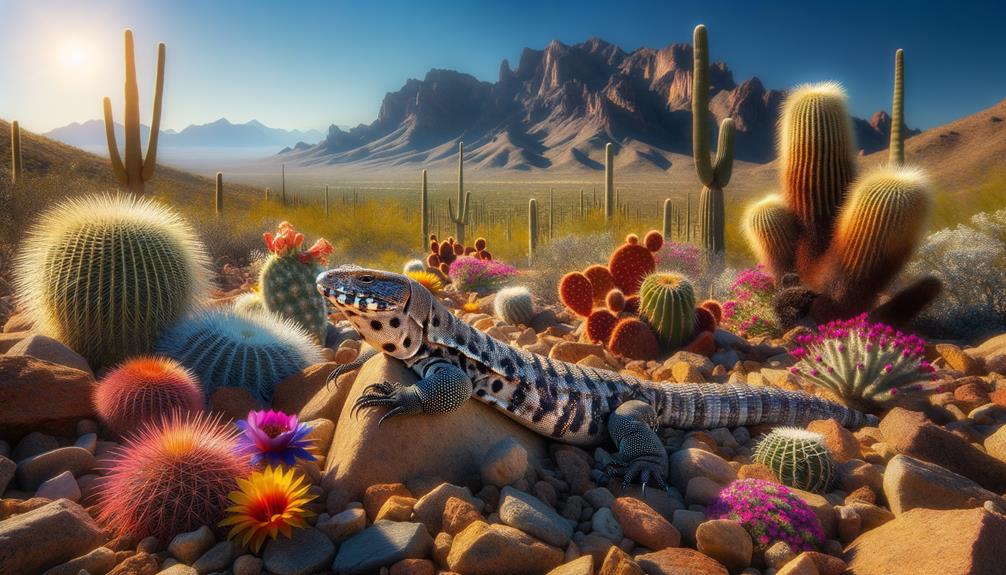I marvel at the rich diversity of reptiles thriving in the Chihuahuan Desert, a testament to nature's resourcefulness. The Texas horned lizard, with its spiked armor and unique defense mechanism, stands out among its peers. The desert is home to over 30 species of snakes, including the Mohave and western diamondback rattlesnakes, which have adapted remarkably to this harsh environment. Lizards have developed remarkable survival strategies, such as thermoregulation and specialized feeding habits, to cope with the desert's extreme conditions. Observing these reptiles' intricate behaviors and adaptations paints a vivid picture of life in this stunning landscape. There's still much to learn about these resilient inhabitants.
Key Takeaways
The Texas horned lizard's spiky appearance and blood-squirting defense mechanism are just a couple of examples of the unique adaptations found in Chihuahuan Desert reptiles.
The western diamondback rattlesnake has mastered the art of camouflage, using its counter-shading coloration to blend seamlessly into its desert surroundings.
A staggering 18 reptile species are found only in the Chihuahuan Desert, highlighting the region's remarkable biodiversity.
Conservation efforts in the Chihuahuan Desert focus on protecting habitats, engaging local communities, and conducting scientific research to ensure the survival of reptilian species.
Two remarkable examples of desert survival strategies are the Texas horned lizard's ability to drink water through its feet and the western marbled whiptail's unique asexual reproduction method.
Iconic Reptiles of the Chihuahuan Desert
The Chihuahuan Desert, a region of stark beauty and remarkable biodiversity, is home to some of the most iconic reptiles on the planet. The Texas horned lizard, revered as the state reptile of Texas, stands out as a fascinating symbol of this arid landscape. Its distinctive spiky appearance and unique survival mechanisms capture the imagination.
In this vast desert, reptiles play vital roles, both as predators and prey. The Texas horned lizard's broad, flat body and crown of horns allow it to blend seamlessly into the sandy terrain. When threatened, it can release blood from its eyes, a remarkable defense mechanism that underscores the fierce spirit of survival that permeates the Chihuahuan Desert.
The Mohave rattlesnake and the western diamondback rattlesnake, among other notable species, share this habitat, each contributing to the desert's intricate web of life. These reptiles, including the Texas horned lizard, highlight the Chihuahuan Desert's unique biodiversity, with at least 18 species found only in this region. The interplay of these iconic reptiles paints a vivid picture of life thriving against the odds in one of Earth's most challenging environments.
Adaptations to Desert Life

Reptiles in the Chihuahuan Desert have developed remarkable adaptations to survive in this harsh environment where water is scarce. In Big Bend National Park, you'll find these resilient creatures employing a range of survival strategies to thrive. For instance, the western diamondback rattlesnake has evolved counter-shading coloration, allowing it to blend seamlessly with its surroundings to avoid predators and ambush prey. This snake can also regulate its venom delivery, conserving its resources for when they're most needed.
The Texas horned lizard is another marvel of adaptation. It can squirt blood from its eyes as a defense mechanism. Its specialized feet utilize capillary action to drink water from the ground, a clever solution to the desert's dryness. Many reptiles in this region are ectotherms, relying on behavioral thermoregulation by basking in the sun to warm up or retreating underground to cool down.
Reproductive strategies, such as viviparity and egg-laying, are also tailored to the arid climate, ensuring the next generation's survival.
| Adaptation | Example Species |
|---|---|
| Counter-shading | Western diamondback rattlesnake |
| Blood-squirting | Texas horned lizard |
| Capillary action feet | Texas horned lizard |
These remarkable adaptations demonstrate the ingenuity of life in the Chihuahuan Desert.
Snake Species and Their Habitats

Among the rugged landscapes of the Chihuahuan Desert, over 30 snake species inhabit diverse microhabitats, each adapted with fascinating behaviors and traits unique to this arid environment. Big Bend National Park, a jewel of the Chihuahuan Desert, is home to some of these remarkable serpents. The western diamondback rattlesnake, North America's largest rattlesnake, can grow up to 6 feet and is a prominent resident here. Its venomous bite and distinctive rattle are well-suited for both defense and hunting in this harsh terrain.
The Trans-Pecos ratsnake is equally fascinating, known for its impressive size and tree-climbing abilities. This species exemplifies the adaptive versatility of snakes in the desert, thriving in both rocky outcrops and wooded areas. Other species, like the coachwhip and Mohave rattlesnake, showcase specialized behaviors and physical traits to endure the region's extreme temperatures.
Snake populations in the Chihuahuan Desert serve as crucial indicators of ecosystem health. Reptile surveys in parks such as Big Bend have been instrumental in tracking these species, providing valuable data for conservation efforts. Understanding these reptiles' habitats and behaviors not only enriches our knowledge but also highlights the desert's ecological significance.
Lizard Varieties and Behaviors

The lizards of the Chihuahuan Desert have evolved remarkable adaptations and behaviors to survive in one of North America's most inhospitable environments. Within the National Parks of this desert, the Texas horned lizard stands out for its unique defense mechanism – squirting blood from its eyes to deter predators and gain a crucial escape.
The greater earless lizard's ability to blend seamlessly with the desert's soil and rocks is a testament to nature's ingenuity. This camouflage is vital for both hunting and protection. Spiny lizards, including the Texas banded gecko, have developed ectothermic physiology, which helps them conserve water in the arid habitat.
The western marbled whiptail has an extraordinary reproductive strategy: it can reproduce without males, ensuring species survival even when mates are scarce. Many Chihuahuan Desert lizards, like the Texas banded gecko, can detach their tails to evade predators. These adaptations and behaviors demonstrate the resilience and evolutionary marvels of these desert-dwelling reptiles, making them a fascinating subject for visitors to the region's National Parks.
Conservation Efforts and Challenges

Conserving the Chihuahuan Desert's diverse herpetofauna requires a multifaceted approach that addresses habitat degradation, engages local communities, and leverages scientific research to inform effective management strategies. With over 170 reptile and amphibian species, including 18 endemics, this desert's ecological tapestry is intricate and fragile. Habitat degradation and fragmentation pose significant threats, making it crucial to protect key habitats.
In Big Bend National Park, ongoing monitoring and inventory efforts provide valuable data. This information enables park managers to make informed decisions, ensuring that conservation measures are proactive, not just reactive. The delicate balance herpetofauna maintain as both predators and prey underscores their significance to ecosystem health. Their sensitivity to environmental changes makes them critical indicators of the desert's well-being.
Collaboration is vital. Park managers, scientists, and the public must work together to safeguard these reptiles and amphibians. Engaging local communities fosters a sense of ownership and responsibility, creating a powerful ally in conservation. By combining traditional knowledge with cutting-edge research, we can navigate the challenges ahead and ensure that the Chihuahuan Desert's reptilian marvels continue to thrive.
Frequently Asked Questions
What Kind of Lizards Are in the Chihuahuan Desert?
The Chihuahuan Desert is home to a diverse range of lizards, each uniquely adapted to this harsh environment. I've had the chance to encounter Texas banded geckos, Texas horned lizards, greater earless lizards, Western marbled whiptails, and spiny lizards, showcasing the incredible variety of species that thrive in this desert.
Why Is the Chihuahuan Desert Considered Biologically Diverse?
The Chihuahuan Desert's remarkable biodiversity impresses me, boasting an astonishing 170 species of reptiles and amphibians. This unique ecosystem's delicate balance and thriving food web are supported by its endemic species and healthy amphibian populations.
How Many Species Are in the Chihuahuan Desert?
The Chihuahuan Desert is a hotbed of biodiversity, with over 170 reptile and amphibian species calling it home. What's more, 18 of these reptile species can't be found anywhere else on the planet. This remarkable diversity is a testament to the natural world's incredible adaptability and resilience.
Why Are There so Many Reptiles in the Desert?
I believe there are so many reptiles in the desert because adaptations like ectothermy, burrowing, and water conservation allow them to flourish in extreme temperatures and aridity, showcasing nature's resilience and evolutionary brilliance in such harsh environments.



